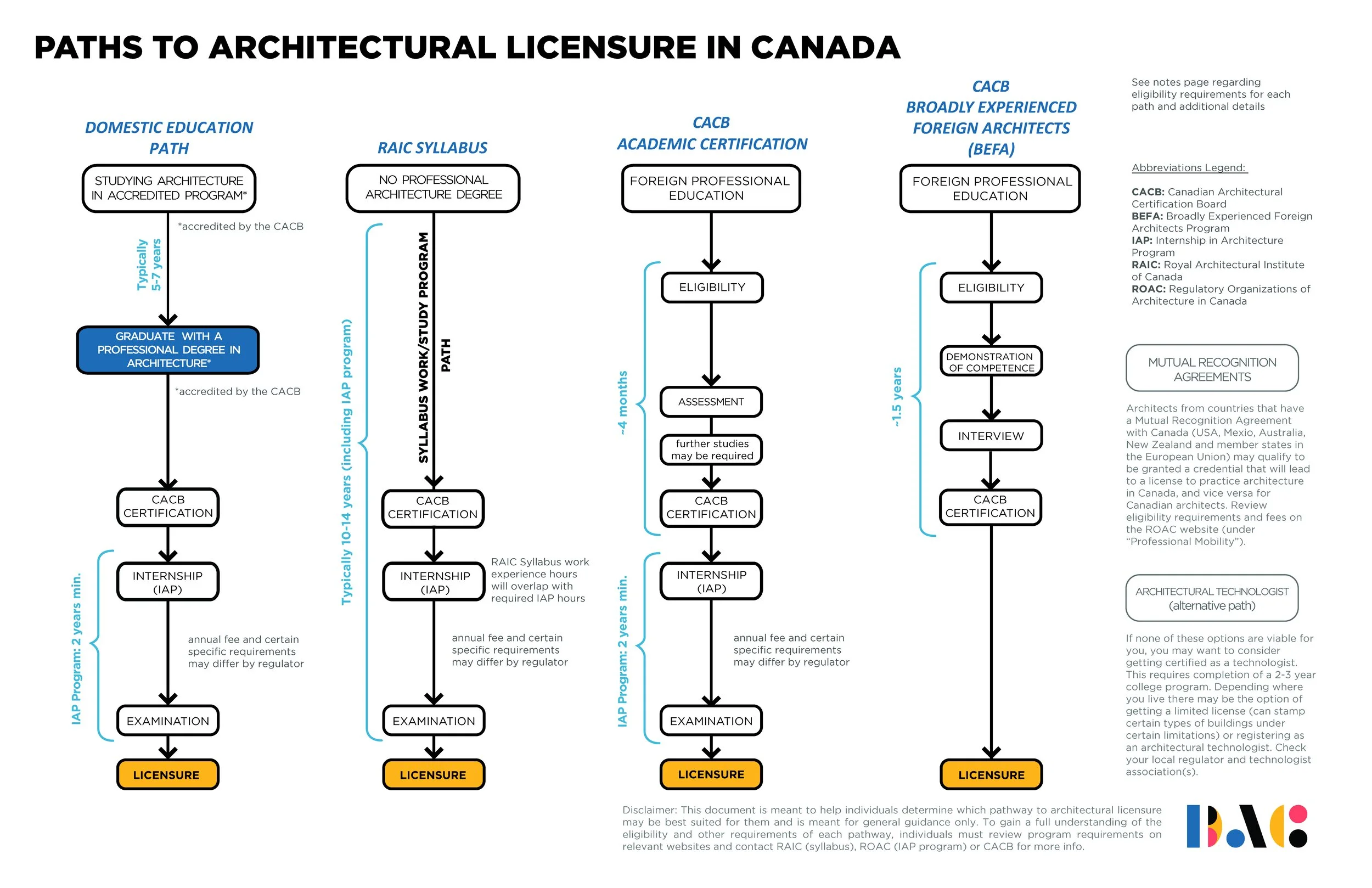Architecture in Canada
“In Canada, the practice of architecture is regulated by the provinces and territories that delegate this responsibility to the associations of architects through legislation.
The provincial and territorial associations of architects are responsible for the conduct of architects within their jurisdictions.” RAIC
You can find the contact information and website for each association here.
-
The Regulatory Organizations of Architecture in Canada (ROAC) represents the eleven provincial and territorial regulators of the profession of architecture in Canada. These regulatory bodies are responsible for setting the standards for entry into the profession and for issuing registration/licenses to those who meet established standards of qualifications and practice. These regulators individually regulate the practice of architecture so that the public interest is protected within their respective province or territory. Through ROAC, the Canadian architectural regulators work collectively to develop and adopt nationally recognized standards and programs which meet their regulatory responsibilities as well as the needs of the architectural profession. Learn more here.
-
The Royal Architectural Institute of Canada (RAIC) is a not-for-profit, national organization dedicated to representing architects and architecture since 1907. The RAIC is the only national voice for excellence in the built environment in Canada focused on providing Canada’s architectural community with the tools, resources, and education to elevate their practice. The RAIC is committed to showcasing how design enhances quality of life, while advocating for important issues of society through responsible architecture. The RAIC’s purpose is to create a better world for all by empowering Canada’s architectural community. Through their work, the organization envisions a strong architectural community that is valued and empowered to create change. Learn more here.
-
There are 12 accredited schools of architecture in Canada.
Schools are accredited by the Canadian Architectural Certification Board (CACB). Attending an accredited architecture program is part of the typical path to becoming a licensed Architect in Canada, but there are alternative paths as well.
-
As indicated on the CACB website, the CACB receives its mandate from the Canadian Architectural Licensing Authorities (CALA) and the Canadian Council of University Schools of Architecture (CCUSA) in order to:
Certify educational qualifications of individual architectural graduates;
Accredit professional architecture programs at Canadian universities;
Certify professional qualifications of broadly experienced foreign architects; and
Collaborate and conduct research, nationally and internationally, as it relates to architectural accreditation and academic certification.
-
BAC-DAC has a number of friends and allied organizations that have helped to promote our events and to work with us on our initiatives. Some of these organizations include the following:
BAIDA - Black Architects and Interior Designers Association
CASA - Canadian Architecture Student Association
CAFE - Canadian Architecture Forums on Education
BEA - Building Equality in Architecture (chapters include: Northern Canada, West Coast, Calgary, Prairies, Toronto, and Atlantic Canada)
There are many local architecture and design societies throughout Canada. Check with your regulator and talk with local architects to find out what organizations exist in your community!
Path to Licensure
To be a licensed Architect, you will need to complete the three E’s:
EDUCATION
The majority of Architects complete a master’s degree in architecture from a university program accredited by the Canadian Architectural Certification Board (CACB).
An alternative way to become an Architect is through an “apprenticeship” offered through the RAIC Syllabus Program.
EXPERIENCE
To obtain experience, you must complete the Internship in Architecture Program (IAP). This program is offered through the association of architects (regulator) in each province and its requirements are specific to the particular jurisdiction. Once registered in the program, your Supervisor—a licensed Architect at your place of employment—is responsible for overseeing your progress. Your Mentor—a licensed Architect—will act as external support and help to guide your work. Your Supervisor & Mentor both need to review and sign off on each of your Canadian Experience Record Book (CERB) submittals. On average, individuals complete the program in approximately 3-4 years.
EXAMINATION
Passing the Examination for Architects in Canada (ExAC) is one of the final steps in becoming a licensed Architect. Architects in Canada are licensed at the provincial or territorial level.
Some provincial or territorial associations have additional requirements in order to become licensed.
*For a comprehensive overview of the different paths to licensure, check out the diagram we put together here!
Info for Internationally Trained Architects
The Toronto Society of Architects (TSA) brings together helpful resources for internationally trained professionals looking to continue their architectural careers. Learn more here.
You can also check out the video from BAC-DAC’s Foreign Trained Architects networking event for more info.
Professional Mobility
ARCHITECTS REGISTERED IN CANADA
Canadian architects currently registered/licensed and in good standing with another provincial or territorial architecture association in Canada may seek membership as a Registered Architect in another Canadian jurisdiction through the Canadian Reciprocity Application for Registration.
ARCHITECTS REGISTERED OUTSIDE OF CANADA
Architects registered in another jurisdiction outside of Canada may be eligible to apply for registration in Canada under the terms of a Mutual Recognition Agreement (MRA). These MRAs are formal agreements between architectural regulators in different international jurisdictions to mutually recognize the architectural credentials and qualifications of their registrants, and to provide a pathway for them to obtain registration across participating jurisdictions. Registration under the terms of an MRA is a streamlined process. Eligibility requirements vary for each MRA. Today, Canada has agreements in place with the United States and Mexico, the Asia Pacific Economic Cooperation (APEC), and a soon-to-be ratified agreement with Europe (ACE).
